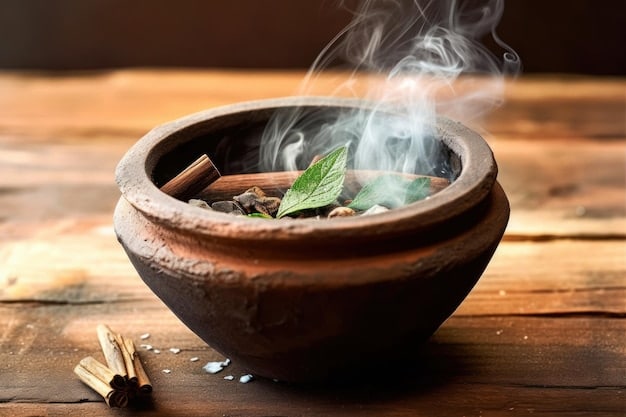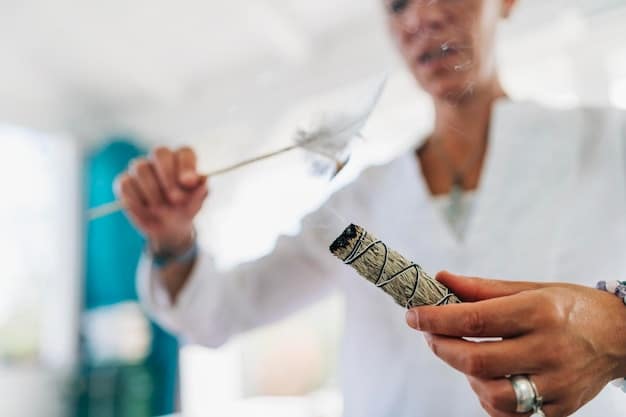Afterpay & ZIP Available
Same-day dispatch on orders before 3pm
10% OFF your first order: WELCOME10

The practice of burning sage, commonly referred to as “smudging,” has profound roots in the spiritual traditions of both Native Americans and ancient India. While white sage is often associated with Native American purification ceremonies, Indian cultures have their unique practices involving various types of sage for cleansing spaces, purifying the air, and promoting healing.
This ritualistic use of sage has transcended continents and epochs, evolving into a beloved practice in contemporary homes around the globe. This article delves into the journey of Indian sage burning.
By exploring the deep-rooted history and shared values of these traditions with Native Americans, we shed light on the enduring significance of sage burning across diverse cultures.

In ancient India, the burning of sage was a cornerstone of religious ceremonies, spiritual cleansing, and medicinal practices.
Deeply rooted in Ayurveda, India’s age-old system of medicine, sage was highly esteemed for its healing properties. It was thought to sharpen mental clarity, ease stress, and protect against diseases.
Beyond its physical benefits, sage burning held deep symbolic meaning within Indian mythology, epitomizing purification, safeguarding, and serving as a conduit to elevated consciousness.
Parallelly, the use of white sage by Native cultures in purification rituals underscores a profound respect for connecting the human and spiritual worlds. This practice, integral to many Native American traditions, involves the smudging of white sage to cleanse a person or space of negative energies, facilitating sacred space for healing and spiritual guidance.
The reverence for white sage in these cultures is not just about the physical act of burning the plant but embodies a deeper connection with Mother Earth and the universe’s intricate energies.
Both traditions share a common understanding of the importance of harmonizing the physical and spiritual realms, using the sacred act of burning sage as a bridge between them.
The use of white sage in Native cultures, alongside the varied types of sage in ancient Indian rituals, highlights a universal respect for nature’s power to heal, protect, and purify.
This reverence for sage transcends cultural boundaries, illustrating a shared belief in its capacity to connect us more deeply with the spiritual world and Mother Earth.
The historical use of sage, from white sage in different cultures to its counterparts in ancient India, reveals a rich tapestry of spiritual practices that honour the interconnectedness of the human and spiritual worlds.
These practices underscore a collective wisdom that recognizes the importance of having a harmonious relationship with nature and the divine, a principle that remains profoundly relevant in our journey toward holistic well-being and spiritual awakening.

Traditionally, the practice of sage burning has been a cornerstone in various cultural ceremonies around the world, playing a particularly significant role in Indian and Native American spiritual practices.
In Indian traditions, sage burning is integral to weddings, festivals, and religious ceremonies, serving not just to purify the environment of negative energies but also to imbue spaces with positive vibrations.
The ritual use of sage bundles in these contexts goes beyond mere practicality; it is a profound way to establish a spiritual connection with ancestors and the divine, effectively bridging the earthly realm with the spirit world.
In the rich tapestry of Native American spirituality, the use of smudge sticks—tightly bound bundles of white sage and other herbs—is deeply rooted in the practice of cleansing and purification. This ritual is not only about clearing physical spaces but is also a deeply spiritual act that invites communication with the spirit world.
Smudging is considered a sacred way to cleanse the soul of negative thoughts and energies, facilitating a clearer channel to the spirit world and enhancing one’s connection to one’s spirituality. People usually prefer smudging with white sage.
This sacred practice acknowledges the powerful intercession of the spirit world in the physical realm, allowing practitioners to draw closer to the spiritual entities that guide and protect them.
The burning of sage bundles and the use of these sticks are symbolic gestures of respect and reverence towards the spirit world, embodying a crucial aspect of Native American spirituality and its understanding of the universe’s interconnectedness.
The cultural significance of these practices lies in their ability to transcend mere ritualistic actions, fostering a deep spiritual harmony between individuals, their communities, and the broader universe.
Through the act of sage burning and using these sticks, individuals engage in a timeless tradition that reinforces their spiritual identity and connection to the ancestral wisdom that guides their way of life.
This spiritual practice serves as a vital link between the past and present, ensuring the continuation of a rich cultural heritage that honours the profound relationship between the human experience and the spirit world.

As the world evolved into a global village, the sacred tradition of sage burning, deeply rooted in Indian spirituality, began to resonate beyond its geographical origins. This practice, once confined to the ceremonies of specific cultures, has been embraced and adapted by a diverse array of communities worldwide.
Notably, the use of sage sticks, a practice borrowed from Native American culture, has become a significant element in this global spiritual awakening.
These tightly bound bundles of herbs, often including sage, are lit, and the smoke is used to cleanse spaces of negative energies, facilitating a serene environment conducive to meditation and well-being.
The transition of sage burning into modern usage is a testament to the universal appeal of its core principles: purification, protection, and spiritual connection. In Western wellness and spirituality movements, the smudge stick has emerged as a symbol of self-care and holistic healing, bridging ancient wisdom with contemporary lifestyle practices.
The act of burning herbs, particularly through the use of sage sticks, has been popularized for its potential to enhance mental clarity, reduce stress, and create a space for meditation and reflection.
This widespread adoption reflects a growing appreciation for the spiritual practices of Native American culture, where sage sticks are used not just for physical cleansing but as a ritual to honour the sacredness of life and the interconnectedness of all beings.
The ritualistic burning of herbs in sacred ceremonies has inspired a modern movement towards mindfulness and spiritual wellness, encouraging individuals to incorporate these ancient practices into their daily routines.
The significance of this transition lies not just in the adoption of sage sticks for cleansing and meditation but in the broader acknowledgement of the importance of spiritual hygiene in today’s fast-paced world.
As individuals seek ways to reconnect with themselves and the environment, the practices of sage burning and smudge stick use offer a tangible link to the ancient traditions that understood the profound impact of the spiritual on the physical realm.
The journey of sage burning from sacred ceremonies in Indian and Native American cultures to its place in modern homes around the world highlights the enduring human need for spiritual connection and the timeless appeal of ancient wisdom in addressing contemporary challenges.
Through the continued use of smudge sticks and the ritualistic burning of herbs, we honour the traditions of our ancestors while forging a path towards greater mental, emotional, and spiritual well-being.

In contemporary wellness and spirituality, sage burning has transcended its traditional boundaries to become a versatile and integral practice within the daily routines of many households.
Recognized for its potent ability to clear negative energy, this sacred herb is now a staple in meditation areas, yoga studios, and homes seeking to create a sanctified and harmonious environment.
The sweetly scented smoke released during sage burning is not only cherished for its pleasant aroma. Still, it is also highly regarded for its capacity to purify spaces, objects, and individuals from lingering negativity. You can even conduct the art of aromatherapy using aroma sticks at home.
This practice of sage burning, particularly in rituals aimed at cleansing new homes or personal belongings, reflects a deep-seated belief. It can provide spiritual benefits that can be achieved through such sacred rituals.
The act of smudging with sage is thought to reset the energy of a space or object, making it conducive to positive vibes and a peaceful atmosphere. This ritual is especially valued in modern life, where the quest for peacefulness and spiritual alignment is often challenged by the hustle and bustle of daily living.
Moreover, the contemporary use of sage underscores a commitment to sustainability and ethical consumption. With the popularity of sage burning rising, there’s an increasing awareness of the importance of sourcing this sacred herb responsibly.
Ethical sourcing practices ensure that the use of sage for spiritual practices does not deplete natural resources or exploit indigenous cultures from which these traditions originate.
This conscientious approach highlights a broader movement towards sustainability in spiritual practices, where the benefits of rituals like sage burning are balanced with respect for the earth and its inhabitants.
The integration of sage burning into modern wellness practices also reflects a broader understanding of its spiritual benefits. The scented smoke is believed to facilitate a deeper connection to the spiritual realm, aiding in meditation and yoga practices by creating a purified space free from negative energy.
This aspect of sage burning aligns with the contemporary pursuit of wellness, where physical, mental, and spiritual health are seen as interconnected and essential to overall well-being.

The ancient practice of burning sacred herbs, notably sage, has piqued the interest of the scientific community in recent years. Researchers have embarked on a journey to demystify the health benefits attributed to the scented smoke produced by sage burning, a practice deeply rooted in indigenous cultures around the globe.
This endeavour aims not only to validate the spiritual and emotional benefits that many have experienced firsthand but also to understand the potential of sage as a natural purifier capable of cleansing the air of harmful bacteria.
The reverence for sage and its use in rituals across various indigenous cultures underscores a profound understanding of the natural world’s healing powers. These traditions passed down through generations, speak to a holistic approach to well-being, where spiritual, emotional, and physical health are intricately connected.
Scientific investigations into sage burning have thus far revealed promising insights, particularly regarding its antimicrobial properties and ability to neutralize negative ions in the environment. This aligns with the longstanding belief in the sage’s capacity to purify spaces, contributing to a healthier living environment.
Moreover, studies focusing on the psychological effects of sage burning have noted its potential to alleviate stress and enhance overall mood. The calming effect of the sweetly scented smoke, coupled with the ritual’s meditative aspects, may play a significant role in this observed benefit.
However, the scientific community continues to debate the extent to which these effects are attributable to the physical properties of sage versus the placebo effect—a phenomenon where the mere belief in the treatment’s efficacy brings about positive outcomes.
Despite these debates, the practice of sage burning persists, supported by a wealth of anecdotal evidence and the profound spiritual significance it holds for many.
It’s crucial, however, to approach this practice with respect for its origins in indigenous cultures, acknowledging the sacredness of the herb and the knowledge systems that have championed its use for centuries.
As research progresses, it is hoped that a deeper knowledge of both the scientific and spiritual benefits of sage burning will emerge, bridging the gap between ancient wisdom and modern science.

The journey of Indian sage burning from ancient rituals to contemporary homes, while a testament to its timeless appeal and adaptability, also raises important conversations around cultural appropriation.
As it continues to evolve, the practice remains a bridge between the past and present, offering a moment of reflection, purification, and connection in the hustle and bustle of modern life.
By embracing sage burning with mindfulness and respect for its origins, we can ensure that this ancient tradition continues to enrich our lives in meaningful ways.

Collections
Subscribe
Sign up to our mailing list to get 10% off your first order, find out about new products and weekly sales.
2024 Incensen
Thank you for signing up for Incensen.
Your 10% off code is:
Sign up for our mailing list to get 10% off your first order and learn about new products and sales.